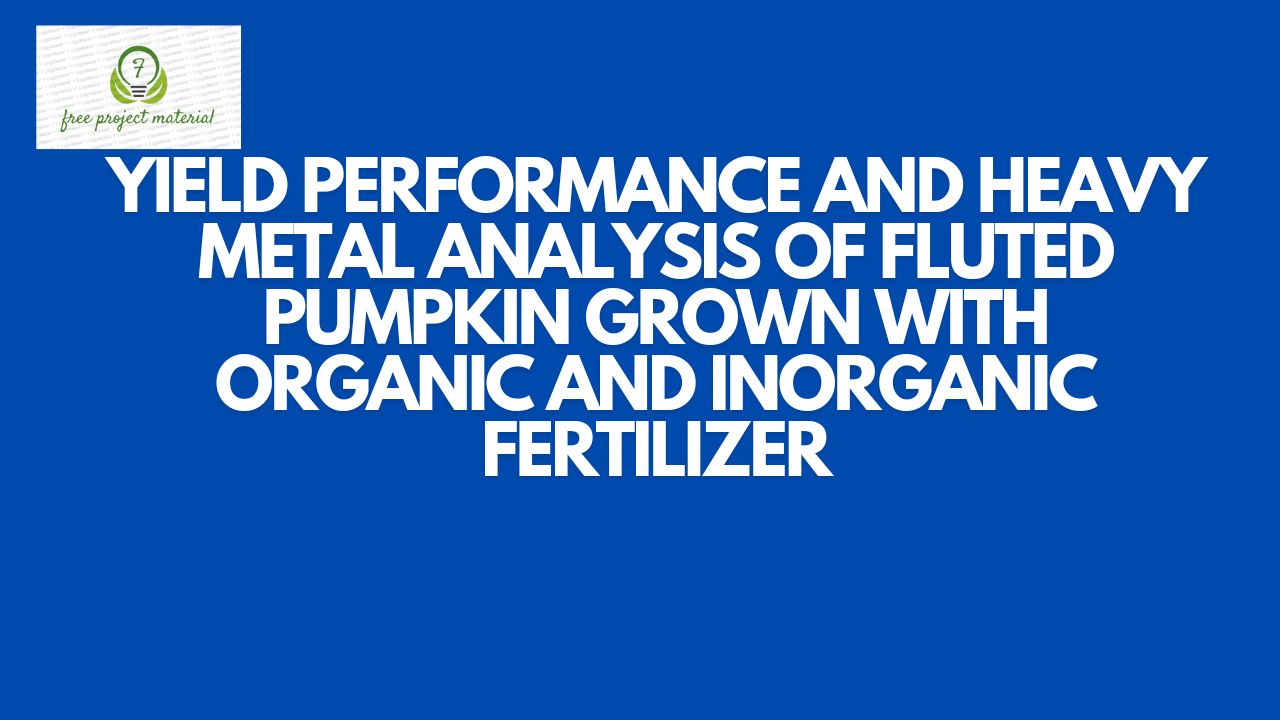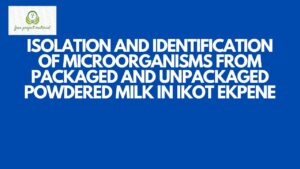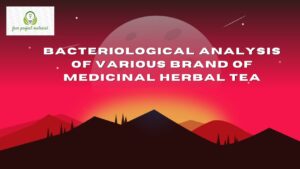ABSTRACT
The study on the yield performance and heavy metal composition of fluted pumpkin cultivated with organic and inorganic fertilizer was carried out using standard analytical methods. The result of the study revealed that Lead, Chromium and iron (0.216±0.002 mg/kg, 2.586±1.18 mg/kg and 27.830±0.011 mg/kg respectively) were higher in the fluted pumpkin planted with inorganic fertilizer than that of organic fertilizer (0.051±0.002 mg/kg, 0.047±0.042 mg/kg and 12.430±0.045 mg/kg respectively). Cadmium was slightly higher in the fluted pumpkin planted with organic fertilizer than vegetable planted with inorganic fertilizer. However, all the heavy metal analyzed where within the WHO permissible limit, except for chromium which was slightly higher in the fluted pumpkin planted with inorganic fertilizer. Since chromium also an important plant nutrients, it implies that both plant samples were good for human consumption. Thus, it is recommended that Both fertilizer and organic manure are good for the cultivation of fluted pumpkin if applied in moderate amount.
TABLE OF CONTENTS
Title Page – – – – – – – – – i
Declaration – – – – – – – – – ii
Certification – – – – – – – – – iii
Dedication – – – – – – – – – iv
Acknowledgement – – – – – – – – v
Abstracts – – – – – – – – – vi
Table of Contents – – – – – – – – vii
CHAPTER ONE
1.0 INTRODUCTION
1.1 Background of the Study – – – – – – 1
1.2 Aim and Objectives of the Study – – – – 5
1.3 Scope and Limitation of the Study – – – – 5
CHAPTER TWO
2.0 LITERATURE REVIEW – – – – – 6
2.1 Heavy Metal – – – – – – – 8
2.2 Sources of Heavy Metals – – – – – – 10
2.2.1 Natural Sources – – – – – – – 10
2.2.2 Anthropogenic Sources – – – – – – 13
2.3 Effect of Heavy Metals on Plants – – – – 15
2.3.1 Cadmium – – – – – – – – 15
2.3.2 Mercury – – – – – – – – 16
2.3.3 Chromium – – – – – – – – 18
2.3.4 Lead – – – – – – – – – 19
2.3.5 Arsenic – – – – – – – – 21
2.4 Toxicological Impacts of Heavy Metals – – – 21
2.5 Production and Management of Fluted Pumpkin – – 22
2.6 Nutritional Value of Fluted Pumpkin – – – – 24
2.7 Uses and Health Benefits of Fluted Pumpkin – – – 24
CHAPTER THREE
3.0 MATERIALS AND METHOD
3.1 Materials – – – – – – – – 28
3.2 Method – – – – – – – – 28
3.2.1 Sample Collection and Experimental Design – – – 28
3.2.2 Sample Preparation – – – – – – 29
3.2.3 Sample Digestion – – – – – – – 29
3.2.4 Filtration of Sample – – – – – – 30
3.3 Determination of Heavy Metal Composition of Samples – 30
CHAPTER FOUR
4.0 RESULTS AND DISCUSSION
4.1 Result – – – – – – – – – 32
4.2 Discussion – – – – – – – – 33
CHAPTER FIVE
5.0 CONCLUSION AND RECOMMENDATION
5.1 Conclusion – – – – – – – – 37
5.2 Recommendations – – – – – – – 37
References
CHAPTER ONE
1.0 INTRODUCTION
1.1 Background of the Study
Environmental pollution has become an extensive and dangerous problem as a consequence of industrial and human activities. Widespread low to high pollution of large areas of agricultural land is a particular problem from indiscriminate sludge discharge from industries, crude oil pollution, and wastes (Ogboi, 2012). Human activities have dramatically changed the balance of biochemical and geological cycles of many heavy metals. An assessment of environmental risk caused by soil contamination is especially important for agricultural as well as non-cultivated areas due to the fact that metals potentially harmful to human health persist in soils for a relatively long time and may transfer into the food chain in considerable amounts (Radmila et al., 2013). The persistent nature of heavy metals in soil due to their non-biodegradability raises environmental concerns because of the interdependence between plants and animals, including humans in the ecosystem (Agbogidi, 2014).
Leafy vegetables tend to accumulate higher concentrations of metals in edible tissue compared to fruit. Vegetables can become contaminated with heavy metals if they are grown on soils contaminated by vehicular exhaust, industrial activities, and other agricultural activities, and their risk to people are of great public concern. Consumption of foods contaminated with heavy metals is a major cause of health problems (Osu and Ogoko, 2014). The levels of heavy metals (lead, cadmium, and copper) were determined in cassava samples from different locations of oil-producing areas of Delta State, Nigeria. The results indicate that the different heavy metals had higher values compared with WHO standard. It has been reported that the leaves of the fluted pumpkin plants planted in farmlands far from major roads accumulate significant amounts of such heavy metals as Pb, Ni, Cd, Zn, Mn, and Fe (Gideon-Ogero, 2008).
Telfairia occidentalis (Fluted pumpkin) is a species of cucurbitaceace family in the tropics largely consumed in Nigeria, Ghana, and Sierra Leone. The common names for fluted pumpkin include Ubong in Ibibio and Ugu in Igbo. It is a creeping vegetable that spreads low across the ground with lobed leaves and long twisting tendrils. It is a warm-weather crop that grows well in low lands and tolerates elevation of some few meters above the ground. It thrives best in soils rich in organic matter (Uboh et al., 2011).
Fluted pumpkin plays important role in human and livestock nutrition. It is a source of protein, oil, minerals, and vitamins. The leaves are low in crude fiber but a rich source of folic acid, calcium, zinc, potassium, cobalt, copper, iron, and vitamins A, C, and K. It also has medicinal values as fluted pumpkin leaves and seeds could be used to increase hematological indices, improve sperm quality, and reduce blood glucose. It is rich in antioxidants, thiamin, riboflavin, and ascorbic acid. The young shoots and leaves of this vegetable are used in preparation of several delicacies in southern Nigeria, including Edikang Ikong Soup (a popular delicacy of the Efiks and Ibibios in Cross River and Akwa Ibom States, Nigeria). It thrives better in the early part of the rainy season, planted between August and October, and can be grown in a garden. It can survive 3-4 years if there is moisture in the soil (Idodo-Umeh and Ogbeibu, 2010).
It is well known that high industrial and traffic activities contribute high levels of heavy metals to the environments. Plants grown around such areas are likely to absorb these metals either from the soil through the roots or from atmospheric contaminants through the leaves (Fifield and Haina, 1997).
The loading of ecosystems with heavy metals may be due to excessive fertilizer and pesticide use, irrigation, atmospheric deposition, and pollution by waste materials (Aydinap and Marinova, 2003). The source of heavy metal in plants is the environment in which they grow and the soil from which heavy metals are taken up by roots or foliage (Okonkwo et al., 2005). Plants grown in polluted environments can accumulate heavy metals in high concentration causing serious risk to human health when consumed. Heavy metals are toxic because they tend to bio-accumulate in plants and animals, bio-concentrate in the food chain and attack specific organs in the body (Akinola et al., 2008). Living organisms require trace amounts of some heavy metals (Fe, Mn, Zn and Cu,) for proper growth and development, however at excessive levels they can pose a health risk to humans and have environmental effects on aquatic organisms (Kisamo, 2003).
1.2 Aim and Objectives of the Study
The aim of this study is heavy metal analysis of fluted pumpkin cultivated with organic and inorganic fertilizer in Akwa Ibom State Polytechnic.
Objectives of the study
The objectives of this study are;
- To determine the heavy metal composition of fluted pumpkin cultivated with inorganic and organic fertilizer.
- To ascertain the impact of inorganic and organic fertilizer on fluted pumpkin
1.3 Scope and Limitation of the Study
This study focused on the heavy metal analysis of fluted pumpkin only cultivated with organic and inorganic fertilizer in Akwa Ibom State Polytechnic. This is due to time and financial constraints.


